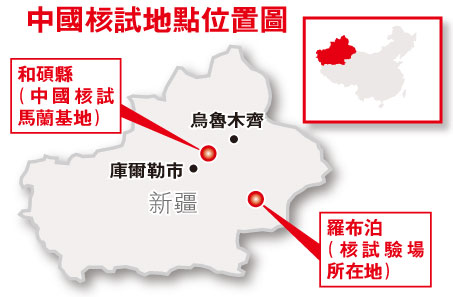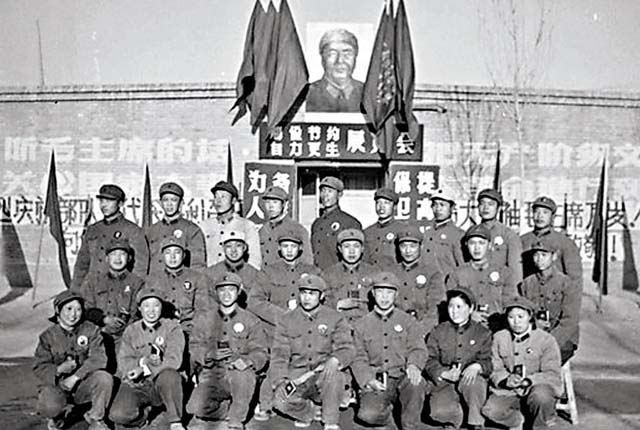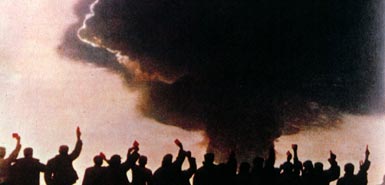明报/中国于1957年在苏联援助下开始研制核弹。在50年代末,一批中国人民志愿军从朝鲜战场返国后,即与科研人员一同秘密前往大西北,进驻新疆马兰核试基地。这支部队全名为解放军第21训练基地,对外编号8023部队。
当年参与“两弹”(原子弹和氢弹)核试的退役人员称,因国家保密要求,他们永远不能透露核试验场区环境、工作情矿及试验情景,“只能把秘密带进棺材”。
据悉,苏联专家原本将核试验场选址在也属沙漠地带的甘肃敦煌,不过核基地首任司令张蕴钰认为离民居太近,另选址在新疆塔克拉玛干沙漠边缘的罗布泊地区。原因是当地是地势平坦的戈壁滩,且常年吹西风,下风方面至敦煌420多公里,其间无居民、无耕地、无牧场,也未发现有开采价值的矿藏资源。
罗布泊被称为“魔鬼之域”
由于罗布泊严禁外人进入,也充满神秘色彩,被称为“魔鬼之域”。1980年著名科学家彭加木在罗布泊考察时失踪,国家曾进行地毯式搜索,但一无所获。8023部队退役军人称,当地天气十分恶劣,常有十级以上大风沙,冬天最低气温达零下30℃,夏天温度则逾50℃。
1996年7月30日,中国宣布暂停核实验,官方才逐步开放罗布泊部分地区,如“楼兰古城”等景点也是在停止核辐射测试后才对外开放的。
日本科学家称中国核试19万人致癌
明报/英国《泰晤士报》19日引述日本科学家研究指,中国1996年前的32年一直在新疆进行的核试验,至少造成19万人因核辐射致癌或死亡,148万人受核辐射影响;中国因核试死亡的人数全球最多。
有当年参与核试的中国军人称,由于防护装备不足,为他们带来严重核辐射后遗症,祸及两三代人,而政府方面赔偿严重不足。

中国核试验地点(资料图片)
报道指出,60年代开始,中国在新疆库尔勒地区和硕县的马兰镇设立核子试验基地,并驻8023核武试验部队在罗布泊核试场,从1964年第一颗原子弹爆炸,至1996年中国宣布停止核试,共进行了46次的地下及地面核试。
“女儿先天长脊髓肿瘤”
“我在8023部队当了23年兵,当时的工作就是进入核爆区收回试验物件和监察各种仪器在核爆后的情。”一名老兵接受《泰晤士报》访问时表示,由于长期暴露在核辐射中,他女儿一出世即被诊断出脊髓内有肿瘤,“医生说我女儿的残疾是核辐射造成的,她做了两次大手术,一辈子都要忍受这些痛苦,但政府给我们的只是每个月130元人民币的补贴。”
报道引述日本最新研究显示,中国在1964年至1996年核试期间造成的人命伤害比任何一个国家都多。扎幌大学医学院物理学教授高田(Takada)称,由于罗布泊核爆后核尘会随风飘散到附近城市及村落,丝绸之路以至整个中国西部均受影响。他以电脑模型计算,中国核试32年间,全中国有148万人受核辐射影响,其中19万人因核辐射造成的癌病或白血病死亡,至少3.5万名婴儿因而畸形或有缺陷。
老兵上访促增加赔偿
过去几年,8023部队老兵在全国各地都出现集体上访,要求政府给予赔偿。另一名女性老兵说,国家在1993年至1996年加快核试计划,她至少参与了10次核试。核辐射为她带来的,除了不断掉头发、体重严重下降,还有长期失眠等慢性疾病,“现在我已无法工作,政府会帮助我吗?”
据悉,官方从2003年开始为曾在核子试验基地服役的军人派发每月300至4200元不等的核岗位津贴,并为因核试死亡军人的家属提供5000元的一笔过补助。不过由于各省市参予核试的军人数目不一,抚恤政策也不统一,部分老兵并未能得到足够补贴。
核试部队上访索偿,当局讳莫如深
苹果日报/素有“死亡之海”之称的新疆罗布泊荒漠,自1960年代开始成为中国的核试验基地。
参与核试而受到核辐射伤害的解放军原8023部队退役人员,早几年开始大规模上访,最终促使当局提高抚恤标准,并着手统计受影响的军人人数,但当局迄今未公开详情,对受害平民情况更是讳莫如深。

原8023部队(资料图片)
1964年10月16日,中国在罗布泊引爆首枚核弹,至1996年7月29日进行最后一次核试,中国前后进行了46次核试,其中对环境污染最为严重的大气层核试有23次。中国官方从未公开罗布泊核试造成的核辐射影响情况,直到2003年大批原8023部队退役军人上访索偿,有关问题才浮现。
至2007年7月,民政部、财政部等部委联合发出《关于做好部分原8023部队及其他参加核试验军队退役人员有关工作的通知》,规定对未享有残疾待遇的患病退役军人,每人每月给予生活补助100元人民币。不过,受害的退役军人仍不满受到歧视,继续联名上书全国人大、中央军委,要求政府给予赔偿。
还核试受害者一个公道!
苹果日报李平/自1945年7月美国进行首次核爆试验至今,全世界总共进行了2,000多次核试。参与核试的军人及核试地区的平民所受到的伤害,近年越来越受到国际社会的关注。公开事件真相、给受害者予经济赔偿,是还核试受害者公道的必由之路,中国着手提高原8023部队退役人员的抚恤,只是迈出第一步。
美国和前苏联的核试次数占了全球的85%,造成的伤害也最为严重。前苏联参与核爆的4.5万名军人,只有2,000人幸存;美国曾在马绍尔群岛进行67次核试,于1980年代成立1.5亿美元的信托基金以赔偿受害者,但至去年已无法支付高达30亿美元的索偿。
法国等国家则在赔偿核试受害者方面取得新进展。去年9月,加拿大宣布当年参加核子试验的全部700名士兵每人将获得2.4万加元(约15.3万港元)赔偿。法国上月宣布,将向阿尔及利亚、波利尼西亚大约15万名受核试辐射伤害的军民,支付总共1,000万欧元(约1.01亿港元)的赔偿金。英国首相白高敦也公开表示,核试对当年的老兵造成伤害,政府欠他们一份“荣誉债”。
核试部队维权路艰辛
由于核试被相关国家列为最高机密,至今大多未解密,令受害者要讨回公道更加困难。在中国,参加核试的原8023部队军人,虽被封为共和国功臣,但他们维权之路甚为艰辛,不只成为各地政府“稳控对象”(维护社会稳定的控制对象)、以防他们集体到北京上访,还在一些示威活动中,遭到公安的暴打。
如今,中国已宣布停止核试、签署联合国《全面禁止核试验条约》,但仍保留新疆的核试基地,只是代号由8023部队改为63650部队。中国当年的核试机密不知何年何月才能公开,罗布泊周边地区民众因核试受到的伤害,还不知要到何年何月才能揭开一些黑幕,才能还受害者一个公道。

From The Sunday TimesApril 19, 2009
Revolt stirs among China’s nuclear ghosts
Up to 190,000 may have died as a result of China’s weapons tests: now ailing survivors want compensation
Michael Sheridan
The nuclear test grounds in the wastes of the Gobi desert have fallen silent but veterans of those lonely places are speaking out for the first time about the terrible price exacted by China’s zealous pursuit of the atomic bomb.
They talk of picking up radioactive debris with their bare hands, of sluicing down bombers that had flown through mushroom clouds, of soldiers dying before their time of strange and rare diseases, and children born with mysterious cancers.
These were the men and women of Unit 8023, a special detachment charged with conducting atomic tests at Lop Nur in Xinjiang province, a place of utter desolation and – until now – complete secrecy.
“I was a member of Unit 8023 for 23 years,” said one old soldier in an interview. “My job was to go into the blast zone to retrieve test objects and monitoring equipment after the explosion.
“When my daughter was born she was diagnosed with a huge tumour on her spinal cord. The doctors blame nuclear fallout. She’s had two major operations and has lived a life of indescribable hardship. And all we get from the government is 130 yuan [£13] a month.”
Hardship and risk counted for little when China was determined to join the nuclear club at any cost.
Soldiers galloped on horseback towards mushroom clouds, with only gas masks for protection.
Scientists jumped for joy, waving their little red books of Maoist thought, while atomic debris boiled in the sky.
Engineers even replicated a full-scale Beijing subway station beneath the sands of the Gobi to test who might survive a Sino-Soviet armageddon.
New research suggests the Chinese nuclear tests from 1964 to 1996 claimed more lives than those of any other nation. Professor Jun Takada, a Japanese physicist, has calculated that up to 1.48m people were exposed to fallout and 190,000 of them may have died from diseases linked to radiation.
“Nuclear sands” – a mixture of dust and fission products – were blown by prevailing winds from Lop Nur towards towns and villages along the ancient Silk Road from China to the West.
The victims included Chinese, Uighur Muslims and Tibetans, who lived in these remote regions. Takada found deformed children as far away as Kazakhstan. No independent scientific study has ever been published inside China.
It is the voices of the Chinese veterans, however, that will reso-nate loudest in a nation proud of its nuclear status but ill informed about the costs. One group has boldly published letters to the state council and the central military commission – the two highest government and military bodies – demanding compensation.
“Most of us are between 50 and 70 and in bad health,” they said. “We did the most hazardous job of all, retrieving debris from the missile tests.
“We were only 10 kilometres [six miles] from the blast. We entered the zone many times with no protective suits, only goggles and gas masks. Afterwards, we just washed ourselves down with plain water.”
A woman veteran of Unit 8023 described in an interview how her hair had fallen out. She had lost weight, suffered chronic insomnia and had episodes of confusion.
“Between 1993 and 1996 the government speeded up the test programme, so I assisted at 10 underground explosions,” she said. “We had to go into the test zone to check highly radioactive instruments. Now I’m too sick to work – will the government help me?”
The price was paid by more than one generation. “My father was in Unit 8023 from 1967 to 1979, when his job was to wash down aircraft that had flown through the mushroom clouds,” said a 37-year-old man.
“I’ve been disabled by chronic immune system diseases all my life and my brother’s daughter was born with a heart defect,” he said. “Our family has spent thousands of yuan on operations over the decades. Two and three generations of our family have such illnesses – was it the nuclear tests? Does our government plan any compensation?”
In fact, the government has already responded to pressure from veterans’ groups. Last year Li Xueju, the minister of civil affairs, let slip that the state had started to pay “subsidies” to nuclear test personnel but gave no details of the amounts.
Such is the legacy of the decision by Chairman Mao Tse-tung, in 1955, to build the bomb in order to make China a great power.
Mao was driven by fear of the US and rivalry with the Soviet Union. He coveted the might that would be bestowed by nuclear weapons on a poor agricultural nation. Celebrations greeted the first test explosion on October 16, 1964.
The scientists staged a total of 46 tests around the Lop Nur site, 1,500 miles west of Beijing. Of these tests, 23 were in the atmosphere, 22 underground and one failed. They included thermonuclear blasts, neutron bombs and an atomic bomb covertly tested for Pakistan on May 26, 1990.
One device, dropped from an aircraft on November 17, 1976, was 320 times more powerful than the bomb that destroyed Hiroshima.
The last explosion in the air was in 1980, but the last underground test was not until July 29, 1996. Later that year, China signed the Comprehensive Test Ban Treaty and, once again, only the sigh of the winds could be heard in the desolation of the Gobi desert.
The financial cost remains secret, but the price of the first bomb was roughly equal to more than a third of the entire state budget for 1957 – spending that went on while at least 30m Chinese peasants died of famine and the nuclear scientists themselves lived on hardship rations.
Rare was the outsider who gained a glimpse of this huge project. One was Danny Stillman, director of technical intelligence at Los Alamos, New Mexico, home of America’s nuclear weapons. He made 10 visits to secret Chinese nuclear facilities during a period of detente and information exchange from 1990 to 2001.
“Some of the videos they showed me were of PLA [People’s Liberation Army] soldiers riding on horses – with gas masks over the noses and mouths of both the horses and the soldiers – as they were riding towards the mushroom cloud of an atmospheric surface detonation,” Stillman recalled.
“It was strange because the soldiers had swords raised above their heads as they headed for the radioactive fallout. I have always wondered how many of them survived.”
Stillman was also allowed to see the lengths to which the Chinese scientists had gone to experiment with annihilation in the desert.
Like the Americans, the Chinese placed caged live animals, tanks, planes, vehicles and buildings around test sites. Such were the remains gathered by the men and women of Unit 8302.
“The surprise to me was that they also had a full-scale Beijing subway station with all supporting utilities constructed at an undefined depth directly underneath,” said Stillman.
“There were 10,000 animals and a model of a Yangtze River bridge,” recalled Wu Qian, a scientist.
Li Yi, a woman doctor, added: “Animals placed two kilometres from the blast centre were burnt to cinders and those eight kilometres away died within a few days.”
China had borrowed Soviet blueprints and spied on the West, according to The Nuclear Express, a book by Stillman and Thomas Reed, the former US air force secretary.
It explains how China then exploited its human capital to win technological parity with the US for just 4% of the effort – 45 successful test explosions against more than 1,000 American tests.
“The Chinese nuclear weapon scientists I met . . . were exceptionally brilliant,” Stillman said.
Of China’s top 10 pioneers, two were educated at Edinburgh University – Cheng Kaijia, director of the weapons laboratory, and Peng Huan-wu, designer of the first thermonuclear bomb. Six went to college in the United States, one in France and one in Germany.
For all this array of genius, no Chinese scientist has dared to publish a study of the human toll.
That taboo has been broken by Takada, a physicist at the faculty of medicine at Sapporo University, who is an adviser on radiation hazards to the government of Japan.
He developed a computer simulation model, based on fieldwork at Soviet test sites in Kazakhstan, to calculate that 1.48m people were exposed to contamination during 32 years of Chinese tests.
Takada used internationally recognised radiation dosage measurements to estimate that 190,000 have died of cancer or leukaemia. He believes 35,000 foetuses were deformed or miscarried, with cases found as far away as Makanchi, near the Kazakh border with China.
To put his findings in perspective, Takada said China’s three biggest tests alone generated 4m times more radioactivity than the Chernobyl reactor accident of 1986. He has called the clouds of fallout “an air tsunami”.
Despite the pall of silence inside China, two remarkable proofs of the damage to health have come from official Communist party documents, dated 2007 and available on provincial websites.
One is a request to the health ministry from peasants’ and workers’ delegates in Xinjiang province for a special hospital to be built to cope with large numbers of patients who were “exposed to radiation or who wandered into the test zones by mistake”.
The other records a call by a party delegate named Xingfu for compensation and a study of “the severe situation of radiation sickness” in the county of Xiaobei, outside the oasis town of Dunhuang.
Both claims were rejected. Residents of Xiaobei report an alarming number of cancer deaths and children born with cleft palates, bone deformities and scoliosis, a curvature of the spine.
Specialists at hospitals in three cities along the Silk Road all reported a disproportionate number of cancer and leukaemia cases.
“I have read the Japanese professor’s work on the internet and I think it is credible,” said one. No cancer statistics for the region are made public.
Some memories, though, remain indelible. One man in Dunhuang recalled climbing up a mountain-side to watch a great pillar of dust swirl in from the desert.
“For days we were ordered to keep our windows closed and stay inside,” recounted another middle-aged man. “For months we couldn’t eat vegetables or fruits. Then after a while they didn’t bother with that any more.”
But they did go on testing. And the truth about the toll may never be known unless, one day, a future Chinese government allows pathologists to search for the answers in the cemeteries of the Silk Road.
The dead of Dunhuang lie in a waste ground on the fringe of the desert, at the foot of great dunes where tourists ride on camels. Tombs, cairns and unmarked heaps of earth dot the boundless sands.
By local tradition, the clothes of the deceased are thrown away at their funerals. Dresses, suits and children’s garments lie half-buried by dust around the graves.
“People don’t live long around here,” said a local man who led me to the graveyard. “Fifty, 60 – then they’re gone.”
Additional reporting: Shota Ushio in Tokyo and Imogen Morizet in Washington
http://www.timesonline.co.uk/tol/news/world/asia/article6122338.ece


